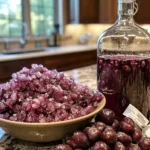Description
Ingredients
For this muscadine wine recipe, you’ll need:
Primary Ingredients:
- 6–8 pounds fresh muscadine grapes (approximately 3 gallons)
- 2–3 pounds granulated sugar (adjust based on desired sweetness)
- 1 packet wine yeast (Champagne or Montrachet varieties work well)
- 1 Campden tablet (for sterilization)
- 1 teaspoon yeast nutrient
- 1 teaspoon acid blend (available at homebrew stores)
- Filtered water
Equipment:
- 1-gallon glass carboy or food-grade fermenting bucket
- Airlock and rubber stopper
- Large nylon straining bag
- Large pot (non-reactive material like stainless steel)
- Hydrometer (optional but helpful)
- Plastic tubing for siphoning
- Wine bottles and corks
- Sanitizing solution
Instructions
Step 1: Prepare Your Muscadines
Muscadine preparation is crucial for extracting maximum flavor in your muscadine wine recipe.
- Sort through your muscadines, discarding any that show signs of mold or damage.
- Rinse thoroughly under cool water to remove any dirt or debris.
- Place grapes in a large, clean pot.
- Using clean hands or a potato masher, crush the grapes to break the skins. Don’t worry about removing seeds at this stage.
- Transfer crushed grapes to a nylon straining bag placed inside your fermenting bucket.
- Squeeze the bag gently to release initial juice.
Tip: For deeper color and more tannins in your wine, let the crushed grapes sit overnight before proceeding to the next step.
Step 2: Create Your Must
The “must” is the mixture that will eventually become your wine.
- To the juice in your fermenting vessel, add enough filtered water to reach about 1 gallon total volume.
- Add 2 pounds of sugar and stir until completely dissolved.
- Crush and add the Campden tablet to kill any wild yeasts or bacteria.
- Cover loosely and wait 24 hours. This waiting period allows the sulfite from the Campden tablet to dissipate while keeping wild yeasts at bay.
Tip: If you have a hydrometer, now’s the time to take your first reading. For a wine around 12% alcohol, you’re aiming for a specific gravity of about 1.090.
Step 3: Start Fermentation
This is where science and magic converge in your muscadine wine recipe.
- Add the acid blend and yeast nutrient to your must and stir well.
- Prepare your wine yeast according to package directions (usually rehydrating in warm water for about 15 minutes).
- Add the activated yeast to your must and stir gently.
- Secure the airlock to your fermenting vessel to allow carbon dioxide to escape while preventing air from entering.
- Place in a warm (70-75°F), dark location.
Tip: Within 24-48 hours, you should see bubbling activity in the airlock. This is a good sign that fermentation has begun!
Step 4: Monitor Primary Fermentation
Primary fermentation is the most active phase of winemaking.
- For the next 5-7 days, gently squeeze the fruit bag daily to extract more color and flavor.
- After 7 days, remove the fruit bag, allowing any free-run juice to drip back into the fermenter before discarding the solids.
- Continue primary fermentation for another 3-5 days, or until bubbling in the airlock slows significantly.
Tip: The must will start sweet and fruity but gradually develop a more alcoholic aroma as fermentation progresses. This is normal!
Step 5: Secondary Fermentation and Bottling
This final step in the muscadine wine recipe requires the most patience but delivers the most reward.
- Carefully siphon (rack) the wine into a clean glass carboy, leaving the sediment behind.
- Attach the airlock and move to a cool, dark place (60-65°F if possible).
- Let the wine clear for 2-3 months, racking again every 30 days to remove sediment.
- Once completely clear, taste the wine and add sugar syrup if desired for sweetness.
- Bottle the wine in sterilized wine bottles and cork securely.
- Allow bottles to age for at least 6 months (though a year is better) before enjoying.
- Prep Time: 90 minutes
- Cook Time: 0 minutes
- Category: Beverage
- Method: Fermentation
- Cuisine: American
Nutrition
- Serving Size: 5 oz
- Calories: 150 per serving
Keywords: homemade muscadine wine recipe, southern muscadine wine, how to make muscadine wine, muscadine fermentation process, best muscadine wine recipe
